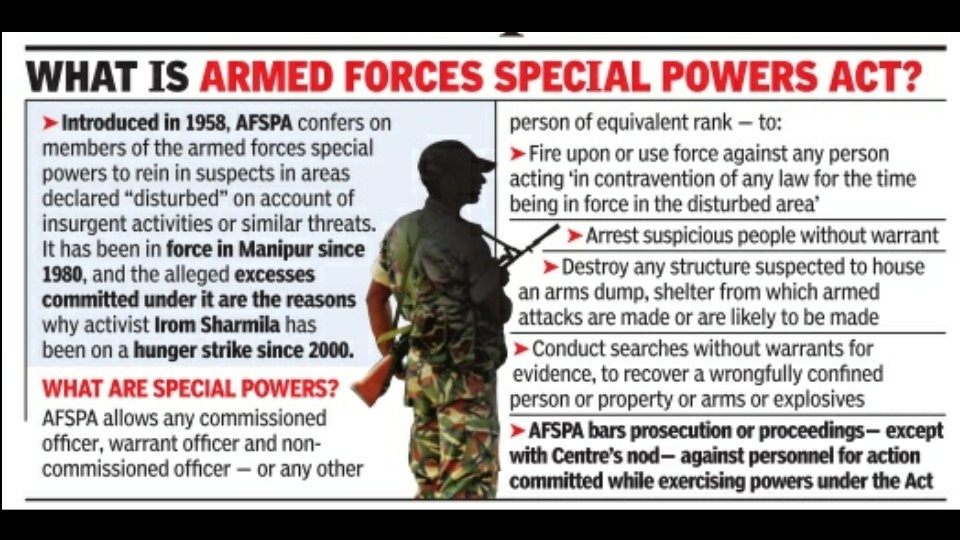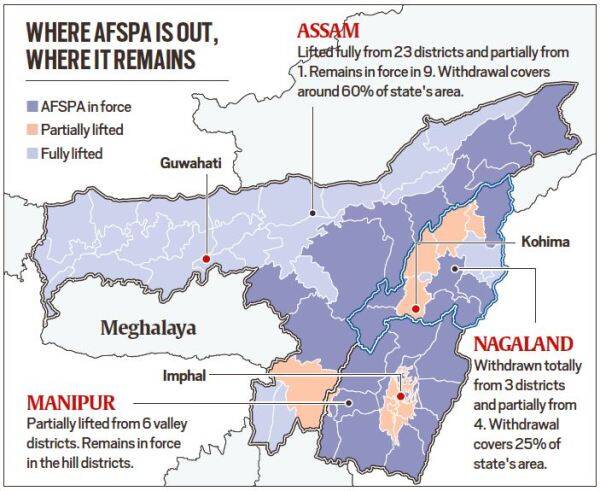Context:
Recently PM said, In a bid to completely lift the Armed Forces (Special Powers) Act of 1958 from the northeast, efforts are on to improve the law-and-order situation in the region.
Relevance:
GS III- Government Policies and Interventions
Dimensions of the Article:
- Armed Forces Special Powers Act (AFSPA)
- AFSPA Acts in force
- Powers Given to an officer of the Armed Forces in a “disturbed” area under AFSPA
- After being in force for many years, why has AFSPA been withdrawn now?
- Why was AFSPA imposed on the Northeast in the first place?
- Arguments Against AFSPA
- Arguments in Favour of AFSPA
- Important Criticisms of AFSPA and commissions regarding AFSPA
- Supreme Court judgment on AFSPA
Armed Forces Special Powers Act (AFSPA)
- Armed Forces Special Powers Act (AFSPA), 1958 is an act of the Parliament of India that grant special powers to the Indian Armed Forces the power to maintain public order in “disturbed areas”.
- AFSPA is invoked when a case of militancy or insurgency takes place and the territorial integrity of India is at risk.
- Security forces can “arrest a person without warrant”, who has committed or even “about to commit a cognizable offence” even based on “reasonable suspicion”.
- It also provides security forces with legal immunity for their actions in disturbed areas.
- While the armed forces and the government justify its need in order to combat militancy and insurgency, critics have pointed out cases of possible human rights violations linked to the act.
- According to The Disturbed Areas (Special Courts) Act, 1976 once declared ‘disturbed’, the area has to maintain status quo for a minimum of 3 months.
- The Acts have received criticism from several sections for alleged concerns about human rights violations in the regions of its enforcement alleged to have happened.

AFSPA Acts in force
It is effective in the whole of Jammu and Kashmir, Nagaland, Assam, Manipur (excluding seven assembly constituencies of Imphal) and parts of Arunachal Pradesh.
History of AFSPA Acts
- An AFSPA Act passed in 1958 was applicable to the Naga Hills, then part of Assam.
- In the following decades it spread, one by one, to the other Seven Sister States in India’s northeast (at present, it is in force in the States of Assam, Nagaland, Manipur, Changlang, Longding and Tirap districts of Arunachal Pradesh, and areas falling within the jurisdiction of the eight police stations of districts in Arunachal Pradesh bordering the State of Assam).
- Another one passed in 1983 and applicable to Punjab and Chandigarh was withdrawn in 1997, roughly 14 years after it came to force.
- An Act passed in 1990 was applied to Jammu and Kashmir and has been in force since.
Powers Given to an officer of the Armed Forces in a “disturbed” area under AFSPA
- After giving such due warning, Fire upon or use other kinds of force even if it causes death, against the person who is acting against law or order in the disturbed area for the maintenance of public order,
- Destroy any arms dump, hide-outs, prepared or fortified position or shelter or training camp from which armed attacks are made by the armed volunteers or armed gangs or absconders wanted for any offence.
- To arrest without a warrant anyone who has committed cognizable offences or is reasonably suspected of having done so and may use force if needed for the arrest.
- To enter and search any premise in order to make such arrests, or to recover any person wrongfully restrained or any arms, ammunition or explosive substances and seize it.
- Stop and search any vehicle or vessel reasonably suspected to be carrying such person or weapons.
- Any person arrested and taken into custody under this Act shall be made present over to the officer in charge of the nearest police station with least possible delay, together with a report of the circumstances occasioning the arrest.
- Army officers have legal immunity for their actions. There can be no prosecution, suit or any other legal proceeding against anyone acting under that law. Nor is the government’s judgment on why an area is found to be disturbed subject to judicial review.
- Protection of persons acting in good faith under this Act from prosecution, suit or other legal proceedings, except with the sanction of the Central Government, in exercise of the powers conferred by this Act.
After being in force for many years, why has AFSPA been withdrawn now?
- The decision has come as the result of a combination of circumstances.
- Over the last two decades, various parts of the Northeast have seen a reduction in insurgencies, some of them up to 60 years old. A number of major groups were already in talks with the Indian government, and these talks received traction during the current regime.
- In Nagaland, all major groups — the NSCN(I-M) and Naga National Political Groups (NNPGs) — are at advanced stages of concluding agreements with the government.
- In Manipur, insurgency as well as heavy militarisation have been on the decline since 2012, when the Supreme Court started hearing a PIL on extra-judicial killings.
- In Nagaland, the killing of 14 villagers in Oting, Mon, is seen as having had a telling impact on reviving the demand to repeal AFSPA.

Why was AFSPA imposed on the Northeast in the first place?
- When the Naga nationalist movement kicked off in the 1950s with the setting up of the Naga National Council — the predecessor of the NSCN — Assam police forces allegedly used force to quell the movement.
- As an armed movement took root in Nagaland, AFSPA was passed in Parliament, and subsequently imposed on the entire state.
- In Manipur, too, it was imposed in 1958 in the three Naga-dominated districts of Senapati, Tamenglong and Ukhrul, where the NNC was active.
- It was imposed in the 1960s in the Kuki-Zomi dominated Manipur district of Churachandpur, which was under the sway of the Mizo insurgent movement, and extended to the rest of the state in 1979, when groups in the Meitei-dominated Imphal Valley groups began an armed insurgency.
- As secessionist and nationalist movements started sprouting in other Northeastern states, AFSPA started being extended and imposed.
Arguments Against AFSPA
- Symbol of Hatred: The Jeevan Reddy Committee, which was founded in 2004, criticised AFSPA as a symbol of hatred, persecution, and a tool of oppression.
- Immunity to Security Forces: AFSPA has been dubbed a “draconian Act” for the unrestricted authority it grants the military forces and the impunity that security officers have for their acts performed under the law. Under AFSPA, the “armed forces” have the authority to shoot to kill or demolish a structure based solely on suspicion.
- Human Rights Issue: The AFSPA’s activities have been criticised because people have died as a result of them. It’s been a contentious issue, with human rights organisations condemning it as being too forceful.
- Prolonged continuation: Despite a nearly 25-year ceasefire accord, the Union Government has been chastised for renewing the “disturbed region” tag on Nagaland every year to keep the AFSPA alive.
- Concerns of AFSPA in Manipur: Many protests over suspected extrajudicial executions by the security forces have taken place in Manipur throughout the years. The bullet-riddled body of Thangjam Manorama, who was reportedly raped and killed by a group of Assam Rifles troops in 2004 sparked outrage across the state. Irom Sharmila, often known as the Iron Lady of Manipur, is a towering figure who is well-known for her 16-year hunger strike in protest of AFSPA atrocities.
Arguments in Favour of AFSPA
- The AFSPA is described as a law that takes a straightforward approach to control criminal activity in disturbed areas.
- Fascist techniques and all groups, private and public, that engage in violence and attempt to pressure the government by organised violence must be controlled. As a result, the AFSPA is vital.
Important Criticisms of AFSPA and commissions regarding AFSPA
- When India presented its second periodic report to the United Nations Human Rights Committee in 1991, members of the UNHRC asked numerous questions about the validity of the AFSPA.
- They questioned the constitutionality of the AFSPA under Indian law and asked how it could be justified in light of Article 4 of the International Covenant on Civil and Political Rights, ICCPR.
- In 2012, the UN asked India to revoke AFSPA saying it had no place in Indian democracy.
- The Act has been criticized by Human Rights Watch as a “tool of state abuse, oppression and discrimination”.
Supreme Court judgment on AFSPA
1997 judgment on AFSPA
- In Naga People’s Movement for Human Rights vs Union of India 1997, a Constitution Bench ruled that the ability to use deadly force under Section 4(a) of the AFSPA should only be used in “certain circumstances.”
- A 1997 Supreme Court judgment advocated “caution and use of minimum force against our own people” in AFSPA regions.
Extra-Judicial Execution Victim Families Association (EEVFAM) case 2017
- The Supreme Court addressed the extrajudicial executions in 2016, clarifying that the bar under Section 6 of the AFSPA does not offer officers “complete immunity” from any investigation into their alleged misconduct.
- The government received severe criticism from the Supreme Court in 2016 for the continuance of AFSPA.
Reactions to the killing of 14 civilians by security forces in Nagaland
- Lok Sabha members condemned the killing of 14 civilians by security forces in Nagaland with some Opposition MPs calling for the repeal of the Armed Forces (Special Powers) Act (AFSPA) as well.
- Nagaland Chief Minister has also called for scrapping the Armed Forces (Special Powers) Act.
- Human rights bodies in India and beyond are debating the contentious AFSPA that gives unbridled powers to the security forces.
- Nagaland Chief Minister also criticised the Centre for extending the “disturbed area” tag on Nagaland every year to prolong the AFSPA despite a ceasefire agreement for almost 25 years.
- In the northeast, the AFSPA is in force in Assam, Nagaland, Manipur, the Tirap, Changlang and Longding districts of Arunachal Pradesh and areas falling within the jurisdiction of eight police stations of the State bordering Assam.
- For Jammu and Kashmir, the Armed Forces (Jammu and Kashmir) Special Powers Act, 1990, is in force.
-Source: The Hindu





